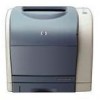HP 2500 HP PCL/PJL reference - Printer Job Language Technical Reference Manual - Page 31
Using PJL, Introduction, Overview of How Commands are Used
 |
View all HP 2500 manuals
Add to My Manuals
Save this manual to your list of manuals |
Page 31 highlights
3 Using PJL Note Note Introduction This chapter describes how PJL commands are used. After reading this chapter, you can create basic jobs and perform simple PJL tasks, such as printer language switching and changing some PJL feature settings. To give you an understanding of where to look for more PJL information, this chapter explains how the manual categorizes PJL commands into groups of related commands. Each command has a brief description of its function to help familiarize you with the PJL language. Each PJL printer supports a different set of PJL commands. See Appendix A for printer-specific information. For information about products newer than those included in this book, see the Printer Job Language Technical Reference Addendum, which includes product-specific information about newer products, as well as commands and variables added to PJL to support these newer products. Overview of How Commands are Used As previously explained, PJL resides "above" other printer languages such as PCL and PostScript. PJL commands encapsulate the printer language jobs, as shown in Figure 3-1. The Universal Exit Language (UEL) command allows the printer to alternate between interpreting PJL commands and printer language commands. (Although PCL and PostScript are shown in Figure 3-1, other printer languages can be involved.) EN Using PJL 3-1















